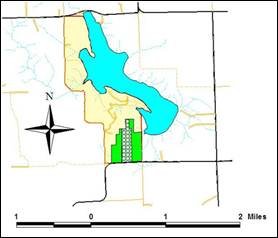Prescribed Burning
Oak Lake Field Station uses prescribed burning to help manage introduced vegetation and promote native prairie diversity. Cool-season grasses (Bromus inermis and Poa pretensis) dominate the grassland communities throughout the station. These grasses are both introduced and will out-compete native prairie grasses and forbs. Prescribed burning in the spring has been shown to set-back these cool-season grasses and promote germination of native warm-season grasses and forbs. Burn history varies across the field station property. Some areas have been burned frequently (every 3-4 years) while others have only been burned a few times. Generally, our burns are conducted as late in the spring as possible before germinating vegetation is too green to burn. This timing varies from year to year but generally occurs between the middle of May and June 1. Prescribed burns are rotated among several grassland areas at the station.
Burn History by Location
| Burn Area | Years of Prescribed Burns |
|---|---|
| Administration Building Flagpole Hill Peninsula Public Access Road Area Restored Field East Restored Field West Shower Unit | 1976, 1996, 2006 1974, 2006, 2009, 2011 1971, 1974, 1975, 1979, 1985, 1997, 2001, 2004,2007, 2010 1998, 2007 2006 1979, 1996, 2002, 2005, 2009 |
Oldfield Restoration
Two agricultural fields on the south end of the field station were historically managed in a three crop rotation (cultivated crops – corn-soybean-smallgrain). These fields were taken out of production in the late 1990’s and were reseeded to six species of native prairie grasses. We initially hayed these fields annually for five years. Following this establishment period, fields were included in our prescribed burn rotation.
Wildlife Food Plot
A third cultivated field (part of the same crop rotation as above) has been maintained in a tilled condition and used to generate a wildlife food plot since the late 1990’s. Corn has been planted to 12 acres of this field each year and rotated throughout the field from year to year. Unplanted areas have been summer-tilled and rested between rotations.

A new grant funded by USDOE and focusing on biofuel development has been approved to examine different combinations of switchgrass alone and with legumes on wildlife diversity. Over the next three years, this project will allow conversion of the tilled, food plot field into a perennial mosaic.
Green fields above have been taken out of production and planted to native prairie grasses. The stippled field is managed as a wildlife food plot and will soon become a mosaic of perennial native grasses and legumes.

